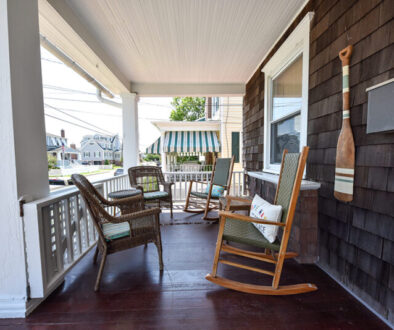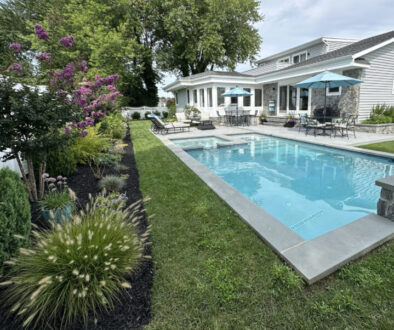Redesigning an Icon
As one of the most photographed houses in Cape May, the John B. McCreary House—known far and wide as The Abbey—has been a stunning property since it was first constructed in 1869. The historic gem is unique not just for its longevity, but for its architecture and design; with a four-story tower and a Gothic Revival style, The Abbey is truly distinctive. Designed by renowned architect Stephen Decatur Button—who also designed legendary locales like Congress Hall—The Abbey is indisputably a Cape May icon.
So, when a team of designers were tasked with making some changes to the interior of the widely recognizable home, they proceeded with all the care and respect a house of The Abbey’s stature deserves.
“The house is a Gothic Victorian, and its famed exterior is a deep reflection on the interior,” says Katie Rementer of Cedar Mill Lane. “It was full of opulent personality when I entered its doors. Lots of furniture, accents, art — lots of everything! My initial intention was just to simplify what was currently there; take out some of the odds and ends while still preserving the heart of what Cape May has come to know and love as The Abbey.”


As the lead designer, Rementer was initially tasked with creating a new kitchen, removing wallpaper in most rooms, and going easy on the rest of the house. Like many of the best-laid plans, however, one thing led to another.
“We brought in Jersey Ice Cream Company because of their master plaster work — I’d worked with them on one prior project in the aesthetics department. They are phenomenal at what they do, and to have them onboard was such a treat,” says Rementer. “Once the decision to plaster was made, it really snowballed into the full makeover you’ll see behind those doors today.”
As the first major part of the project, particular attention was paid to the kitchen. The most challenging part of the design was reconciling the concept of the kitchen as the heart of a modern home with the goal of creating a traditional and period-appropriate design in the house.
“In the Victorian era, great lengths were taken to hide the kitchen from prying eyes, as it was strictly a utilitarian area,” says Rementer. “So how do we remain true to the home, but still make a stunning kitchen? One thing I had to let go of was this idea that the kitchen must match the rest of the home’s aesthetic. That wasn’t going to work here as it wouldn’t have been faithful to the home’s history.”
Instead, the idea was to lean into the concept of the Old English kitchen, utilizing materials like Belgian Limestone flooring, custom inset cabinetry from a small company in Colorado, and solid living brass fixtures from Morocco and England. One of the standout pieces in the kitchen—a custom-built prep island built to Rementer’s specification by Citta Woodcraft in Egg Harbor—is made of solid oak with a custom butcher block and genuine marble top.
There were surprises as well. The kitchen was originally a standard height, though an addition done some time in the past added “owners’ quarters”—complete with a bedroom, bathroom, and closet—directly on top. The team at The Abbey removed the rooms and floors and made the kitchen two stories tall. During the process, they removed a stove and the drywall, knowing something was lurking behind it all—lucky for them, an original fireplace surfaced. It’s now a distinctive part of the kitchen design.
“Jersey Ice Cream Company was a huge part of the Old English design of the kitchen,” says Rementer. “The plaster really wrapped up the entire space perfectly.”

“The plaster throughout the house is gorgeous, but the two-toned plaster in the kitchen was a feat that really paid off,” says Tara Mangini of Jersey Ice Cream Company. “We’ve been using gypsum plaster in our work for years. It brings a layer of character and light to the space that you just don’t get with paint. It’s a game changer.”
Just like the scope of the project expanded—antiquing and auction shopping for turn of the century pieces and sourcing products like genuine antique Thonet Bentwood bistro chairs and salvaged brass lighting from France were just a few of the additional steps undertaken—so too did the roles of the designers. Rementer, who was originally acting as a solo designer, became the primary, while Mangini and her partner, Percy Bright, continued to contribute in non-plaster related ways.
“This was one of those projects that grew and grew! Initially we were brought on to do plaster work, but ended up helping create the visual inspiration for the project as well as guiding the wall finishes throughout the house and choosing the paint colors and wallpaper, as well as the plaster,” says Mangini. “We also helped source some of the vintage furniture, and all the artworks. We came in at the end to help Katie put it all together, which was such a rewarding way to finish things up.”
With a project of this magnitude, of course, everyone involved has their own favorite room or piece. For Rementer, the kitchen takes precedence, with the front living room and adjacent library coming in as close seconds.
“They are two ‘married’ rooms with two distinct personalities,” says Rementer. “The front room has amazing light and it’s just such a refreshing room to be in. We worked so hard to remain true to the history of the home while avoiding anything dim or stuffy. And that marble fireplace had my heart from the day I laid eyes on it. The front room is classic and timeless while still being extremely palatable and unpretentious.”
Juxtaposing the front room is the library, with immensely handsome bookcases that were in the house when the project started. The room and all its trappings have a depth and mystery to them that are emblematic of truly stunning libraries.
For Mangini, favorites include “the sitting room with the vintage floral daybed and all the art! I love every single piece.”
Though the project ran longer and more than initially planned, it allowed the designers to expand their already deep admiration for the house.
“The Abbey is such a wise and worldly entity that depriving it of anything short of the best would be a genuine tragedy,” says Rementer. “Make no mistakes, this house merely allowed us to dress it and we were, at all times, nothing more than guests behind her doors. She is very much her own mistress and it’s an honor to have been included and to have had any hand in her impressive history.”



